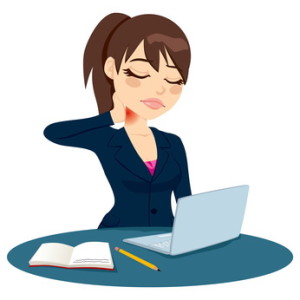Why Is Getting Rid Of Neck Pain A Pain In The Neck?
 It is normal for neck pain to change as corrections are being made to the muscles, tendons and ligaments. It can be normal getting used to a pain in the neck. Changing posture to an area that has been trained to function poorly can be problematic. These structures slowly change and it is possible for the pain to increase a bit as changes are taking place.
It is normal for neck pain to change as corrections are being made to the muscles, tendons and ligaments. It can be normal getting used to a pain in the neck. Changing posture to an area that has been trained to function poorly can be problematic. These structures slowly change and it is possible for the pain to increase a bit as changes are taking place.
Neck problems, especially chronic neck pain, will not change overnight. A new pillow, when chosen correctly, may cause some discomfort for the first few nights, even up to a week or so. Many people will sleep on a quality, supportive neck pillow one night and give up! Patience is a virtue when it comes to getting rid of neck pain.
You may experience muscle soreness when starting an exercise program. This can be expected, however, there should be no increase or worsening in pain. Breaking old habits and forming new ones can be difficult, but persistence is the key.
Initially, the pain stage should not be severe, but more like a sore neck.
Expect a bit of soreness or symptoms of a stiff neck usually around the first week of treatment. This is a reaction that is sometimes noted, while others experience immediate positive effects. Either way, it is an indication that things are changing.
I would call a patient later that night of their first treatment and that is what I would normally get and explain to the patient. Pain better – great! Pain not better – I would ask about any changes they have noticed and reassure them it is a normal reaction. I would indicate that, for long standing problems, it took a while to get that way and it may take a while to get back to normal. We may not get normal; we may only get 20%, maybe 40 or 50%, and most people who have been suffering from chronic neck pain would be happy to have 50% of it gone. However, the goal is always 100%. If the pain is from an neck injury, quick relief should not be expected. Things have to start healing and inflammation must calm down and this takes some time.
When there is a noticeable change in neck posture often seen with adjustments, using traction devices, new pillows and exercises, try to notice changes in neck pain symptoms; either better, slightly worse or a change in the pattern of neck pain.
We want no neck pain and usually combining the right supportive pillow, mild traction and exercise produce a noticeable relief of pain indicating we’re on the right path. Just because there is an initial reaction of soreness or stiffness, is not an indication to stop or abruptly change course. Most often it is temporary and relatively mild. Just like braces on your teeth, you would expect some discomfort and time to correct problems.
Heads Up!
One bit of information you normally don’t hear is, if you have neck pain, you should be extra careful to prevent falls, as a pain in the neck can also cause disturbances in postural balance. According to a 2014 study Journal of the Medical Association of Thailand, patients with neck pain showed a higher incidence of postural balance problems than those without.
This is even seen in younger individuals with chronic neck pain from flexor muscle fatigue. A 2015 study in the journal Gait & Posture found changes in postural control and muscle activation patterns after neck flexor fatigue in young subjects. Looking down at smart phones can cause undue activation of the neck flexors and pain commonly called text neck.
A 2013 study in the Journal of Back & Musculoskeletal Rehabilitation showed greater standing postural sway in subjects with myofascial neck pain and can be one a disturbing factor on standing balance.
When Neck Pain Is Not From The Neck
No changes at all after the first week or two is an indication to consider a different approach. Re-evaluate and consider other methods or referral for another opinion. It happens! This would be a pain in my neck, but we should always seek to do what is best. Nobody knows it all. I remember treating a patient for a herniated disc in the neck causing pain into the shoulder. It was confirmed on an MRI and testing gave positive results, therefore, treatment commenced. I was sure we were on the right path. A week went by, two weeks went by and no change.
This was very disappointing for me, but mostly the patient. A new approach was taken by evaluating the shoulder, trying to approach it from the opposite way. Sure enough, I found a problem with the rotator cuff muscles, primarily the supraspinatus muscle. Fortunately, using a very specific form of muscle therapy called active release technique, and although the treatment was fairly painful, after a few treatments – no pain! The patient was upset at first, but relief is relief and a smile is a smile!
A 2020 Review in Global Spine Journal outlines the importance of distinguishing between shoulder and neck pain because there is overlapping pain pathways. We often find cervical pathology mimicking shoulder pain, but the opposite is also true; shoulder pathology can also mimic neck pain. There is also the possibility that both neck and shoulder pathologies exist together.
The authors of the study indicate, “Specific examination tests used to differentiate shoulder and spine pathology are critical as imaging studies may be misleading.” The authors state, “Knowledge of anatomy, pain referral patterns, shoulder kinematics, and examination techniques are invaluable to the clinician in making an appropriate diagnosis and guiding treatment.”
Please don’t get alarmed or too frustrated when the pain increases a bit or there is a change in the symptoms after initially starting something new. Correcting posture along with some of the products and methods described at NeckSolutions may take some time.
It is important to have a good attitude and stop saying or pondering, this is a not working and I’m going to stop! Your state of mind has an effect on symptoms, progress and should not be a roadblock on the way to recovery from neck pain.
Literally saying, “This is a pain in the neck” can be a problem. Similarly with, “I can’t shoulder the responsibility”, or “This will be back breaking work” can be a subconscious factor in chronic pain. I am convinced, “A pain in the a$$” was initiated and promoted by proctologists!

